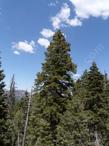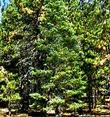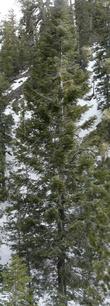Abies concolor
White Fir.
White Fir (Abies concolor) is not at its best where the summer temperatures commonly range above 100 degrees F, but this California fir is much easier in our climate than the Noble Fir (Abies procera). The White Fir is native in some areas of California that have harsh climates, (low snow load, -20 degrees F, followed by sun, and 20 mph winds. White Fir is usually a common member of the Yellow Pine Forest and grows with associated . plants such as Parry's Manzanita (Arctostaphylos parryana), Pinemat Manzanita (Arctostaphylos nevadensis), ., Yellow Pine (Pinus ponderosa), Jeffrey Pine (Pinus jeffreyi), Sierra Currant (Ribes nevadense), etc. White Fir grows slowly, one inch to 2 ft per year, according to how it likes you and your climate. Do not expect it to become a magnificent tree in your lifetime, but it would make a great Christmas tree in the front yard for a long time. White Fir is called white fir because of its white bark. If you live outside of its plant community at lower elevations, this tree will grow best if you can give it a mother tree for the first 10 years of its life; that is, plant at the edge of an oak, fir, or pine (at or just outside the drip line). White Fir also grows well in a garden setting combined with manzanitas (Arctostaphylos spp.), and Coffee Berry (Rhamnus spp.). We have seen this tree looking good in a landscape of boulders, with the afore- mentioned plants, and a heavy mulch of fir bark with brickwork pathways or redwood decking.
Abies concolor tolerates clay.
Foliage of Abies concolor has color green, is evergreen and has fragrance.
Flower of Abies concolor has color blue.
Communities for Abies concolor:Mixed-evergreen Forest and Yellow Pine Forest.
| ph: | 6.00 to 8.00 |
|---|---|
| usda: | 3 to 8 |
| height[m]: | 5.00 to 75.00 |
| width[m]: | 3.00 to 15.00 |
| rainfall[cm]: | 83.00 to 163.00 |




 play movie
play movie


